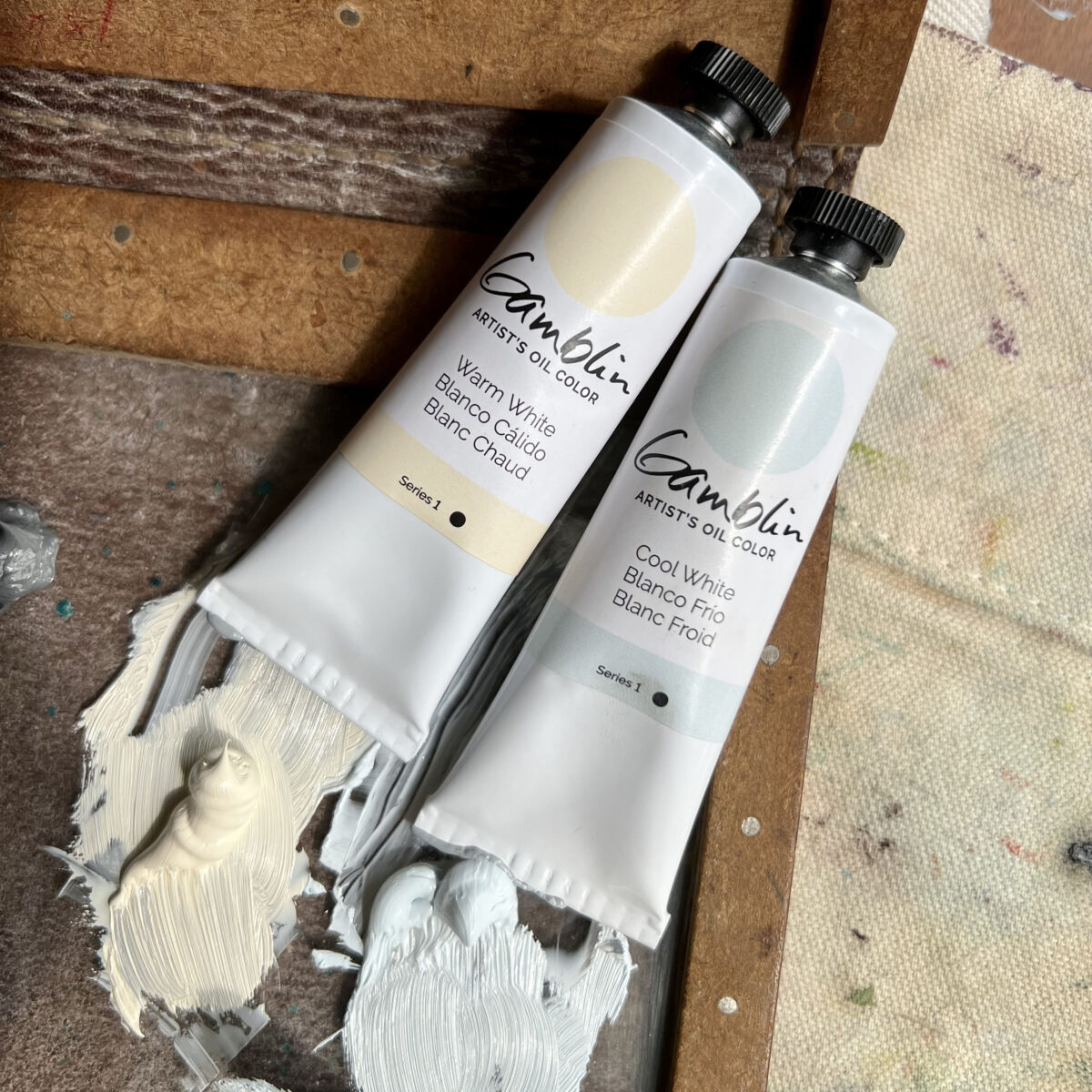
Selecting white oil paint for your artistic intentions
The white we choose determines to a great degree what our experience of painting will be: how our colors will tint and mix, how they will feel under the brush or knife, and how opaque our paint layers will be.
Tinting strength, texture, temperature, and dry time are all important considerations when selecting a white. There is a full spectrum of possibilities and our line embraces them all.

Robert Gamblin “Iceberg Twins”
When Robert Gamblin first started making color, he began by making whites. There were three at the beginning. Over the last 40+ years, we’ve expanded and refined our selection of whites.
We now have 10 different white oil colors to serve your artistic needs!

When choosing your white, think about the white you are currently using.
Why did you choose it?
Would you like it to feel and perform differently?

Texture & Mark-making
The texture of your paint is both the most personal and the most important characteristic. For most painters, it is the feel and mark-making possibilities of their white that is most important to their work. Our whites range from soft and smooth under the brush, to buttery, to stiff and dense.
Soft white
Gamblin’s softest white oil colors are Radiant White and 1980 Titanium White. Without modification, they are the most brushable – meaning these colors have the least amount of resistance under the brush or painting knife.
Buttery white
The buttery whites, Titanium White and Titanium Zinc, are in an ideal middle ground of texture. Straight from the tube, both have a “short” texture – meaning they break cleanly and quickly from the brush and make a beautiful, crisp impasto mark. Neither is too stiff under the brush or knife. And both can be nudged – with just a little medium – to be made softer. With just a little fluid medium, brushability is increased; the paint becomes softer and has more flow.
Stiff white
Gamblin’s stiffest and densest white, Flake White Replacement, exerts a greater amount of resistance under the brush and palette knife. Flake White Replacement handles like lead white. This means it is “longer” in texture – with more pull, or drag, on the brush. This specific quality means it can easily replicate the impasto of a thickly painted Impressionist painting. Flake White Replacement is a re-creation of the basic working properties of traditional lead white without the toxicity of lead carbonate, being made with titanium dioxide pigment. Its binder is a mixture of refined linseed oil and stand oil.

Oil Painting by Anne Marie Coolick
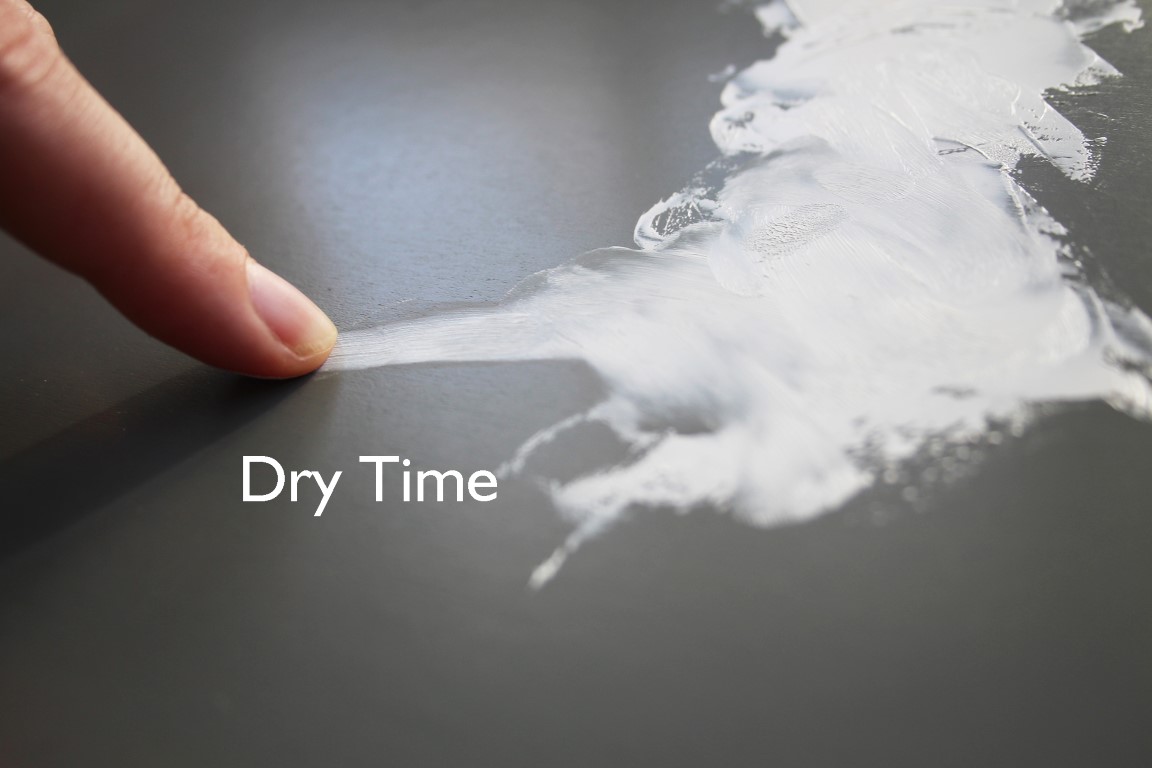
Dry Time
Fast drying white
In general, whites made with linseed oil will dry faster than whites made with safflower, poppy, or walnut oils. For even faster drying, our specialty white Fast Dry Titanium White, is formulated to dry considerably faster than traditional Titanium White. Fast Dry Titanium White retains the working properties of our traditional Titanium White, but will dry a day or two quicker by comparison.
The fast drying rate means painters can stay in the flow of their painting session longer with layering and mark-making possibilities beyond traditional Titanium White.
Slow drying white
For painters that wish to work wet into wet, or otherwise desire more open time without using mediums, we recommend using Radiant White. Radiant White is not modified in any way to be slow drying; it is just naturally the slowest drying white in our range, at about five days in thin layers. Flake White Replacement comes in 2nd as the slowest drying, with a dry rate a day or so faster than Radiant White.

Tinting Strength
Does your white quickly overpower others or subtly alters their value? Strong or weak tinting strength is another consideration for your selection of white. Below are all of our eleven whites used as a tint for Ultramarine Blue to demonstrate their relative tinting strength to one another. At the bottom of this article we have additional visuals to help you compare and contrast the working properties of your white selection.
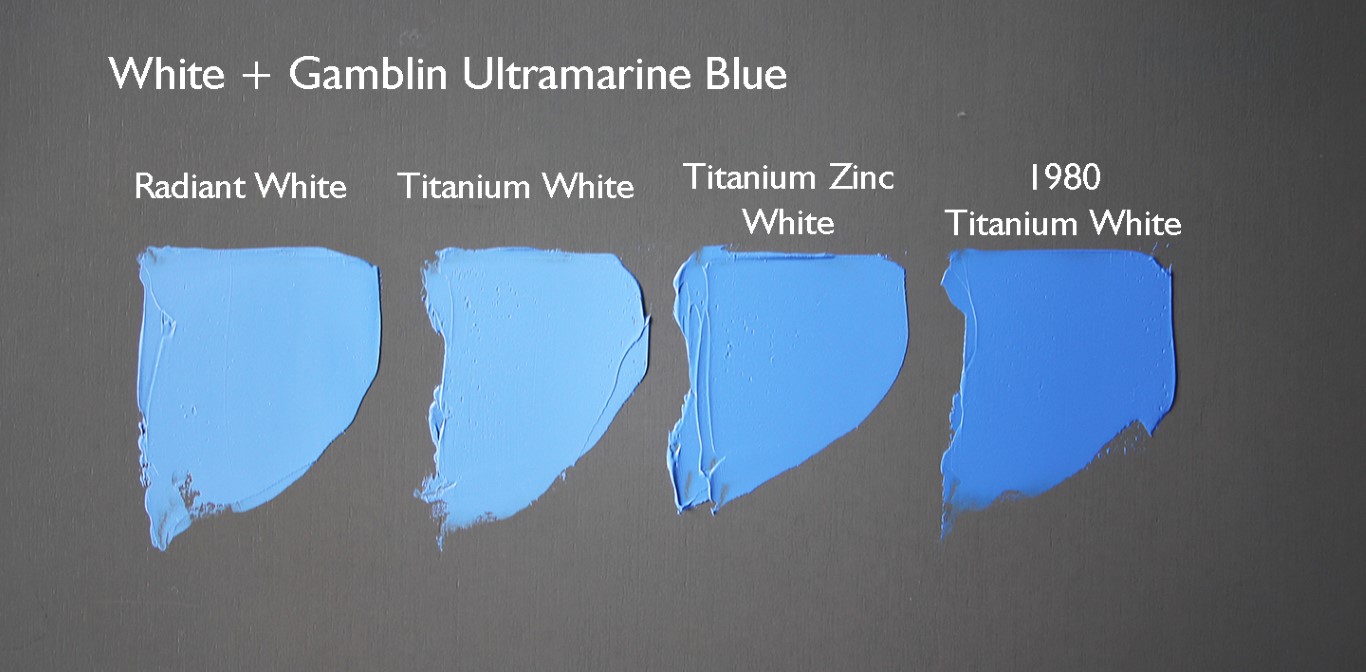

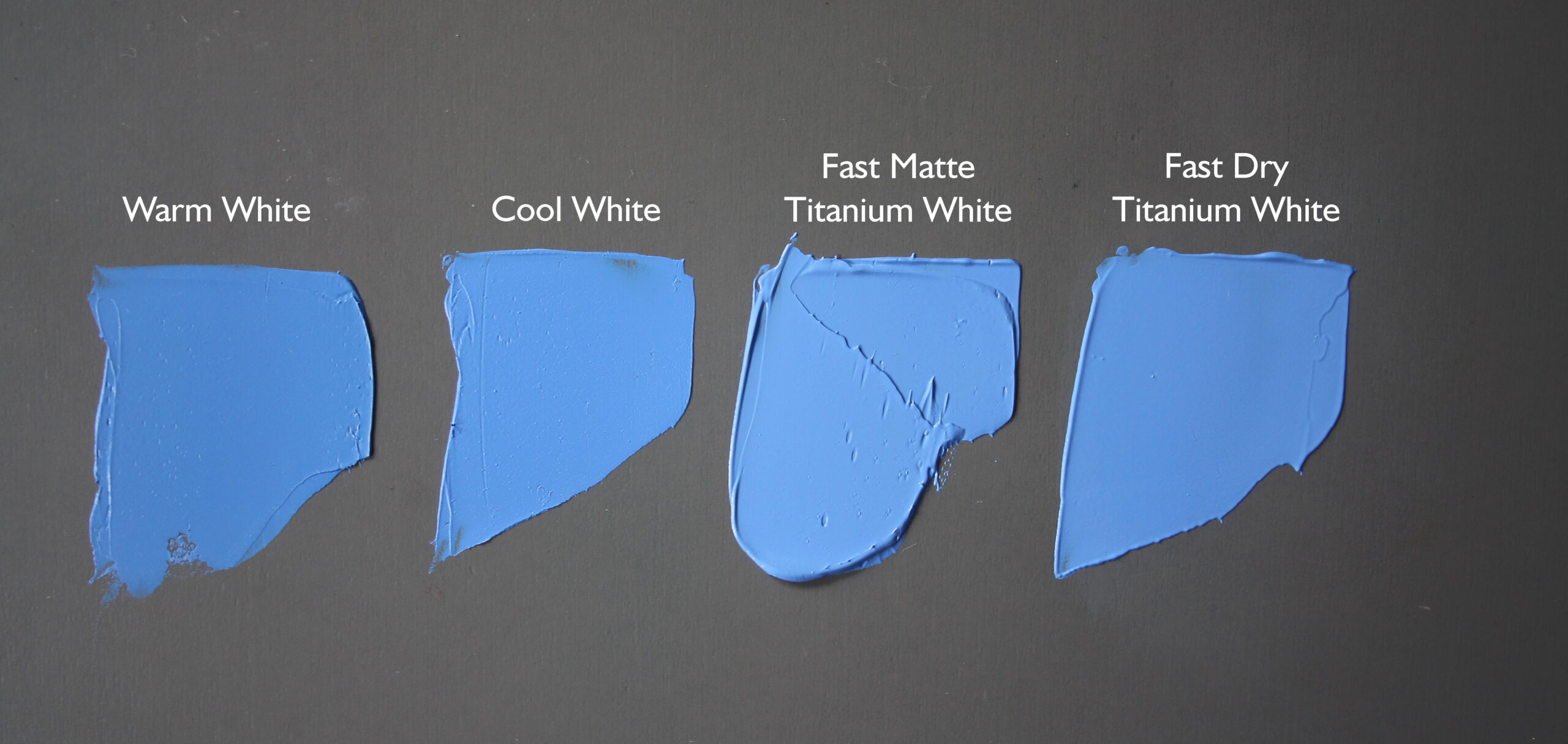

Opacity & Transparency
Opaque white
If your goal is the same as the Impressionists: to simulate the light of the world whether it is landscape, still life, or portraiture, then opaque whites will support this direct painting style.
Titanium White and Radiant White do this better than any of the lead whites the Impressionists had to work with. Gamblin’s opaque Titanium White and Radiant White carry higher loads of titanium and, in turn, reflect back 97% of the light that falls on them versus 93-95% for the lead whites included in our test.
Transparent white
High tint strength and opacity are not for everyone. Renaissance style figurative painting, which strives to show the translucency of skin, is handled best by a more translucent white.
Zinc White is at the end of the spectrum with the weakest tinting strength and incredible transparency. It can be used successfully as a white in glazes and scumbles where the glaze needs to modify light or atmosphere without “whiting out” what is below. Think of depicting the mist where the ocean meets the land, the transparency of a woman’s veil, or the flare of light coming off glass. Zinc White makes this easy to depict where titanium based whites makes this exceedingly difficult.
A note of advice concerning Zinc White: unless you are painting on a panel, Zinc White should not be used as the primary white in an oil painting. Zinc creates a brittle paint film which can cause cracking on stretched fabric supports. Learn more on the pros and cons of zinc oxide on our Tips & Techniques article on the subject.
In 2014, Gamblin brought to market another white with a low tinting strength that contains no zinc oxide. Transparent White, from our 1980 Oil Color line, is an excellent alternative to Zinc White for such purposes. Transparent White is made with titanium pigment but also involves the use of proprietary inert ingredients added to titanium dioxide and marble dust. Perhaps Zinc has met it’s more flexible match!
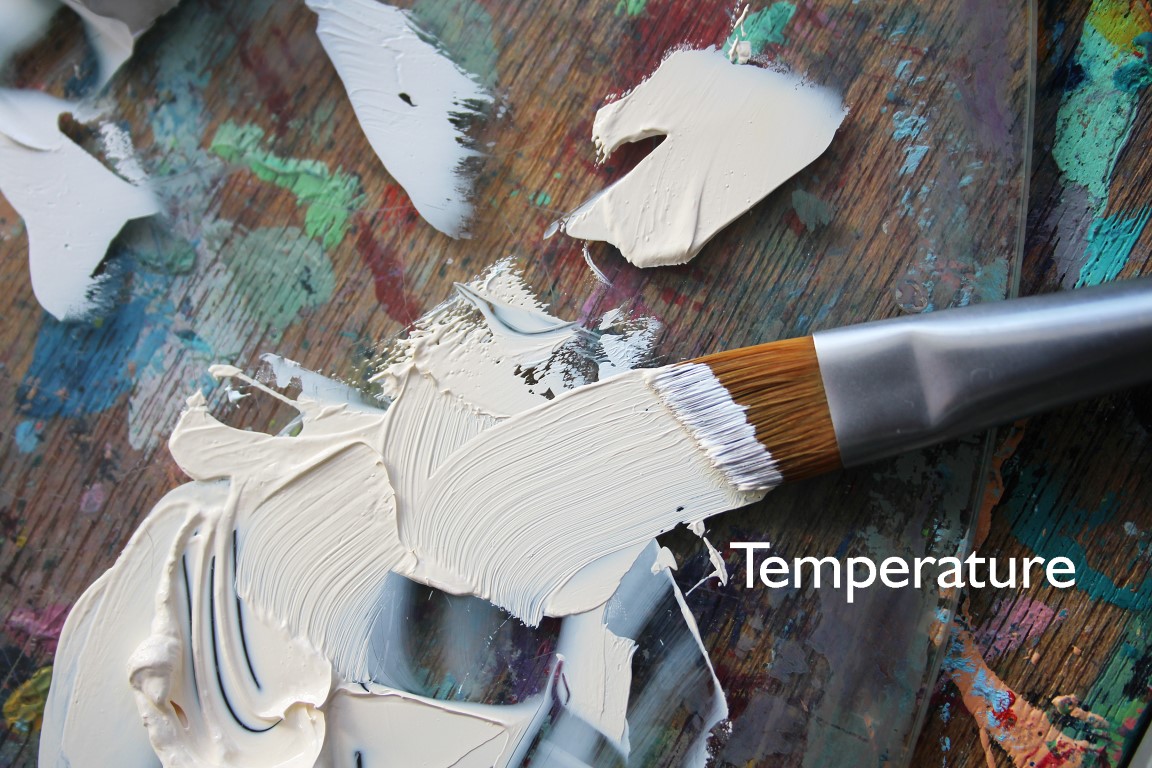
Temperature
Temperature
Linseed oil whites are warmer; safflower oil whites are neutral in color. For most oil painters, the color temperature of the white, which is determined by the oil the white is made with, is not an important consideration. But this will be an important consideration for artists who routinely paint passages of pure white. This is especially true for abstract artists who use white as a color and not as the light within a painting. Upon aging, safflower oil whites hold their color the best: for abstract artists this also means that all colors mixed with safflower whites will also hold their original color the best.
If this describes you, we have Titanium Zinc White, Radiant White and 1980 Titanium White for you to choose from as these are all made with safflower oil binder.
In 2013 we released two new colors, Warm White and Cool White. These unique temperature biased whites are formulated for painters who want to factor the color of the light into their color mixtures. The color of the light source influences all of the other colors in the painting’s subject matter. Using a white that replicates the temperature of your light can create a consistent quality of light and color harmony throughout your painting. More detailed information on these temperatures whites, including painting and color swatch examples, can be found on their dedicated Experience Color page.
Best All-Around White
So you may be wondering now, what is the best white?
“If I had to suggest a single white for all-around use, it would be our Titanium Zinc White,” says Robert Gamblin.

“Expressing color is primary for me and Titanium Zinc White lets that come through. It has a beautiful neutral white color, and its tinting strength is not super high, so colors mixed into it are not overwhelmed by the power of the white. It also dries pretty close in time to linseed oil whites and dries flexible,” he explains.
Note that 1980 Titanium White is another strong contender for the best all-around white. 1980 Titanium White is also neutral in temperature, with a tinting strength that is not over-powering. Both Titanium Zinc White and 1980 Titanium White are bound in safflower oil and have a soft consistency for easy mixing. The great value of our 1980 Oil Colors makes the 1980 Titanium White an excellent choice for the artist who uses a high quantity of white oil color in their work, working large scale or in thick application of color.
Gamblin Whites Selection Chart
We hope this article has helped and also provide the following visuals are helpful as you make your choice. Please note that these are relative in scale, made to compare characteristics such as drying rate, texture, and tinting strength. This information and more can be found in our Catalog and Material Resource Guide.

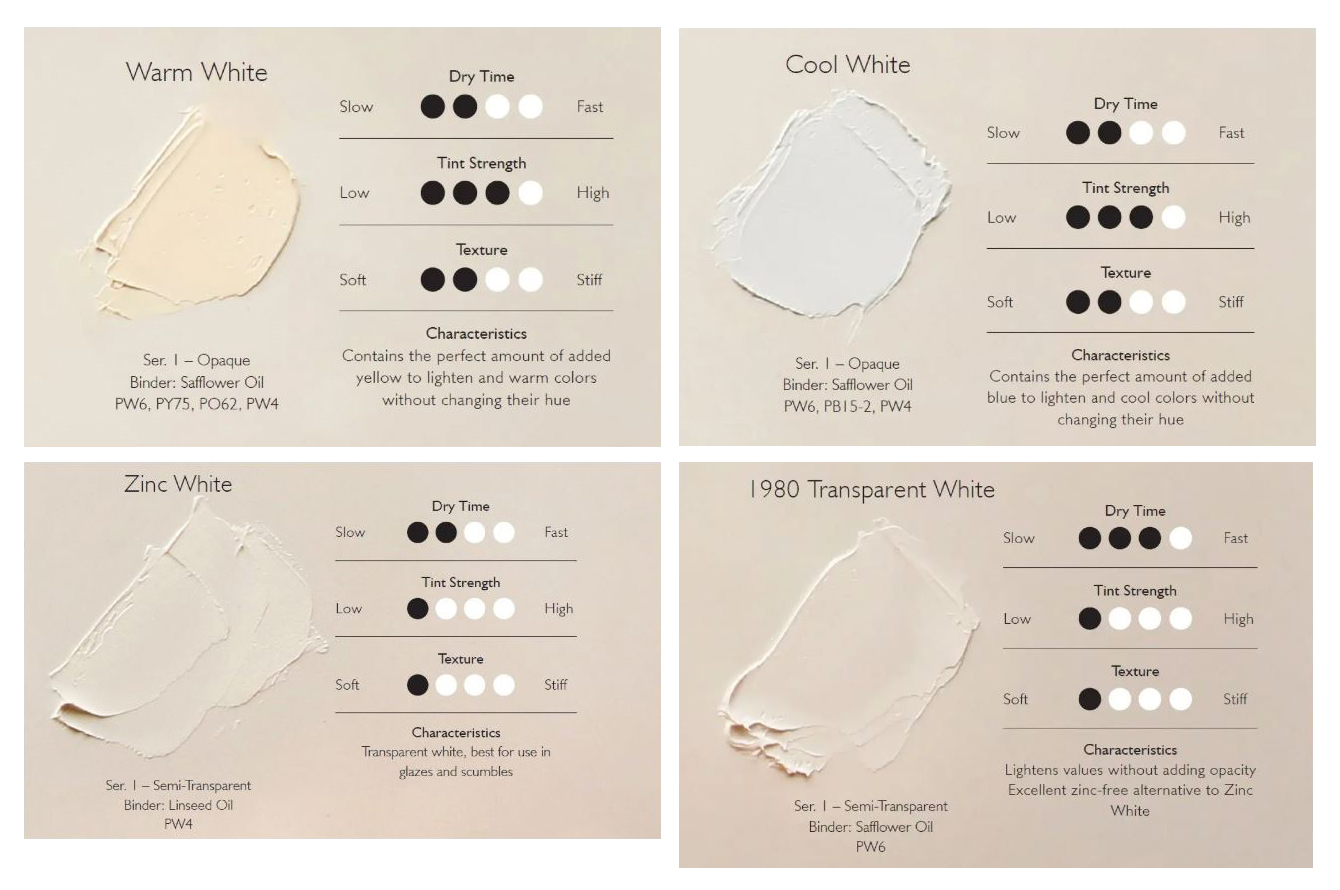

Take me back to the Experience Color menu

